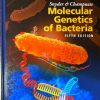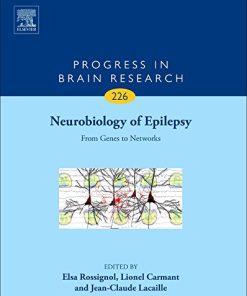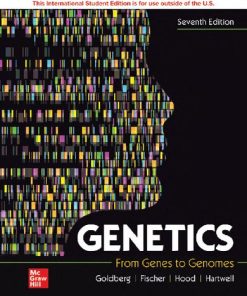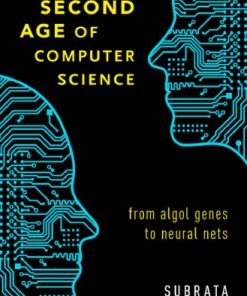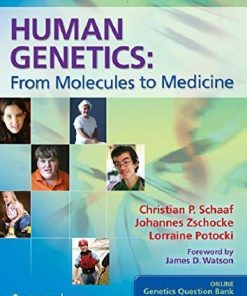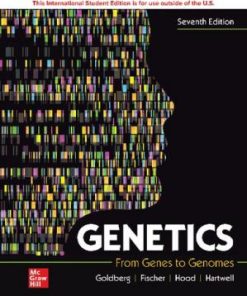(Ebook PDF) Genetics From Genes to Genomes 8th Edition by Michael Goldberg, Janice Fischer 1266125434 9781266125430 full chapters
$50.00 Original price was: $50.00.$25.00Current price is: $25.00.
Genetics: From Genes to Genomes 8th Edition by Michael Goldberg, Janice Fischer – Ebook PDF Instant Download/DeliveryISBN: 1266125434, 9781266125430
Full download Genetics: From Genes to Genomes 8th Edition after payment
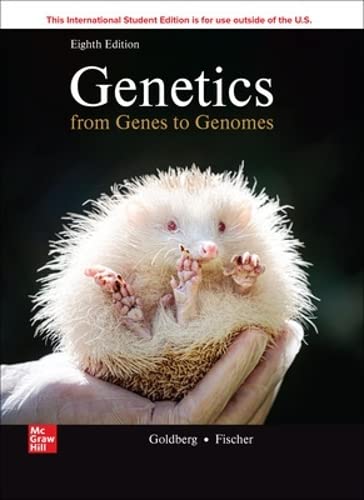
Product details:
ISBN-10 : 1266125434
ISBN-13 : 9781266125430
Author: Michael Goldberg, Janice Fischer
Genetics: From Genes to Genomes represents a new approach to an undergraduate course in genetics. It reflects the way the authors currently view the molecular basis of life. The eighth edition emphasizes both the core concepts of genetics and the cutting-edge discoveries, modern tools, and analytical methods that will keep the science of genetics moving forward.
Genetics: From Genes to Genomes 8th Table of contents:
Chapter 1: Mendel’s Principles of Heredity
Chapter 1 Introduction
Mendel’s Principles of Heredity
1.1 The Puzzle of Inheritance
Mendel Devised a New Experimental Approach
1.2 Genetic Analysis According to Mendel
Monohybrid Crosses Reveal the Law of Segregation
Mendel’s Results Reflect Basic Rules of Probability
Further Crosses Verify the Law of Segregation
Dihybrid Crosses Reveal the Law of Independent Assortment
Mendel’s Laws Predict Probabilities, Not Specific Outcomes
Mendel’s Genius Was Unappreciated Before 1900
Recessive Alleles Are Most Often Nonfunctional, While Dominant Alleles Are Usually Functional
1.3 Mendelian Inheritance in Humans
Pedigrees Aid the Study of Hereditary Traits in Human Families
A Vertical Pattern of Inheritance Indicates a Rare Dominant Trait
A Horizontal Pattern of Inheritance Indicates a Rare Recessive Trait
Solved Problems
Problems
Chapter 2: Extensions to Mendel’s Laws
Chapter 2 Introduction
Extensions to Mendel’s Laws
2.1 Extensions to Mendel for Single-Gene Inheritance
Dominance Is Not Always Complete
A Gene May Have More than Two Alleles
Mutations Are the Source of New Alleles
Pleiotropy: One Gene May Contribute to Several Characteristics
Sickle-Cell Disease Illustrates Many Extensions to Mendel’s View of Single-Gene Inheritance
2.2 Extensions to Mendel for Two-Gene Inheritance
Additive Interactions Between Two Genes Can Produce Novel Phenotypes
Epistasis: One Gene Can Mask the Effects of Another Gene
Summary: A Variety of Biochemical Pathways Can Produce Any Given Altered Mendelian Ratio
Incomplete Dominance or Codominance Can Expand Phenotypic Variation
Locus Heterogeneity: Mutations in Any One of Several Genes May Cause the Same Phenotype
2.3 Extensions to Mendel for Complex Trait Inheritance
The Same Genotype Does Not Always Produce the Same Phenotype
Mendelian Principles Can Explain Continuous Variation
2.4 A Comprehensive Example: Dog Coat Color Genes
Solved Problems
Problems
Chapter 3: Chromosomes and Inheritance
Chapter 3 Introduction
Chromosomes and Inheritance
3.1 Chromosomes: The Carriers of Genes
Genes Reside in the Nucleus
Genes Reside in Chromosomes
3.2 Mitosis: Cell Division that Preserves Chromosome Number
During Interphase, Cells Grow and Replicate Their Chromosomes
During Mitosis, Sister Chromatids Separate and Two Daughter Nuclei Form
Regulatory Checkpoints Ensure Correct Chromosome Separation
3.3 Meiosis: Cell Divisions that Halve Chromosome Number
In Meiosis, the Chromosomes Replicate Once but the Nucleus Divides Twice
During Meiosis I, Homologs Pair, Exchange Parts, and Then Segregate
During Meiosis II, Sister Chromatids Separate to Produce Haploid Gametes
Mistakes in Meiosis Produce Defective Gametes
Meiosis Contributes to Genetic Diversity
Mitosis and Meiosis: A Comparison
Mendel’s Laws Correlate with Chromosome Behavior During Meiosis
Solved Problems
Problems
Chapter 4: Sex Chromosomes
Chapter 4 Introduction
Sex Chromosomes
4.1 Sex Chromosomes and Sex Determination
In Humans, the SRY Gene on the Y Chromosome Determines Maleness
Human X and Y Chromosomes Also Contain Genes Unrelated to Sex
Species Vary Enormously in Sex Determining Mechanisms
4.2 Gametogenesis
Oogenesis in Humans Produces One Ovum from Each Primary Oocyte
Spermatogenesis in Humans Produces Four Sperm from Each Primary Spermatocyte
4.3 Sex Linkage
The Genes for Sex-Linked Traits Are Located on the X Chromosome
The Chromosome Theory Integrates Many Aspects of Gene Behavior
4.4 Sex-Linked and Sexually Dimorphic Traits in Humans
In XX Human Females, One X Chromosome Is Inactivated
Maleness and Male Fertility Are the Only Known Y-Linked Traits in Humans
Autosomal Genes Contribute to Sexual Dimorphism
4.5 Human Intersexuality
Four Distinct Cell Groups Form Human Sex Organs
Mutations in Genes that Act After SRY Can Result in Intersexuality
Solved Problems
Problems
Chapter 5: Linkage, Recombination, and Gene Mapping
Chapter 5 Introduction
Linkage, Recombination, and Gene Mapping
5.1 Gene Linkage and Recombination
Some Genes on the Same Chromosome Do Not Assort Independently—Instead, They Are Linked
Testcrosses Simplify the Detection of Linkage
5.2 Recombination: A Result of Crossing-Over During Meiosis
Reciprocal Exchanges Between Homologs Are the Physical Basis of Recombination
Why Recombination?
Recombination Frequency Reflects the Distance Between Two Genes
Recombination Frequencies Between Two Genes Never Exceed 50%
5.3 Mapping: Locating Genes Along a Chromosome
Comparisons of Two-Point Crosses Establish Relative Gene Positions
Three-Point Crosses Provide More Accurate Mapping
How Do Genetic Maps Correlate with Physical Reality?
Multiple-Factor Crosses Help Establish Linkage Groups
5.4 The Chi-Square Test and Linkage Analysis
The Chi-Square Test Evaluates the Significance of Differences Between Predicted and Observed Values
Applying the Chi-Square Test to Linkage Analysis: An Example
5.5 Tetrad Analysis in Fungi
An Ascus Contains All Four Products of a Single Meiosis
Tetrads Can Be Characterized as Parental Ditypes (PDs), Nonparental Ditypes (NPDs), or Tetratypes (Ts)
Recombination Frequencies May Be Determined by Counting Each Tetrad Type
Ordered Tetrads Help Locate Genes in Relation to the Centromere
Tetrad Analysis: A Numerical Example
5.6 Mitotic Recombination and Genetic Mosaics
Twin Spots Indicate Mosaicism Caused by Mitotic Recombination
Mitotic Recombination Can Produce Sectored Yeast Colonies
Mitotic Recombination Has Significant Consequences
Solved Problems
Problems
Chapter 6: DNA Structure, Replication, and Recombination
Chapter 6 Introduction
DNA Structure, Replication, and Recombination
6.1 Experimental Evidence for DNA as the Genetic Material
Chemical Studies Locate DNA in Chromosomes
Bacterial Transformation Implicates DNA as the Genetic Material
DNA, Not Protein, Contains the Instructions for Virus Propagation
6.2 The Watson and Crick Double Helix Model of DNA
Nucleotides Are the Building Blocks of DNA
The DNA Helix Consists of Two Antiparallel Chains
The Double Helix May Assume Alternative Forms
DNA Structure Is the Foundation of Genetic Function
6.3 Genetic Information in Nucleotide Sequence
Most Genetic Information Is Read from Unwound DNA Chains
Some Genetic Information Is Accessible Without Unwinding DNA
In Some Viruses, RNA Is the Repository of Genetic Information
6.4 DNA Replication
Overview: Complementary Base Pairing Ensures Semiconservative Replication
Experiments with Heavy Nitrogen Verify Semiconservative Replication
DNA Polymerase Has Strict Operating Requirements
DNA Replication Is a Tightly Regulated, Complex Process
The Integrity of Genetic Information Must Be Preserved
6.5 Homologous Recombination at the DNA Level
Tetrad Analysis Illustrates Key Aspects of Recombination
DNA Molecules Break and Rejoin During Recombination
Crossing-Over at the Molecular Level: A Model
DNA Repair of Heteroduplexes Can Result in Gene Conversion
6.6 Site-Specific Recombination
Recombinase Enzymes Catalyze Site-Specific Recombination
Solved Problems
Problems
Chapter 7: Mutation
Chapter 7 Introduction
Mutation
7.1 Mutations: Primary Tools of Genetic Analysis
Mutations Are Changes in DNA Base Sequences
Mutations May Be Classified by How They Change DNA
Spontaneous Mutations Occur at a Low Rate
Spontaneous Mutations Arise from Random Events
7.2 Molecular Mechanisms that Alter DNA Sequence
Natural Processes Cause Spontaneous Mutations Through DNA Damage
Mistakes in DNA Replication Cause Spontaneous Mutations
Mutagens Induce Mutations
Most Mutagens Are Carcinogens
7.3 DNA Repair Mechanisms
Some DNA Base Damage Can Be Reversed
Damaged Bases Can Be Removed and Replaced
Two Important Mechanisms Can Repair Double-Strand Breaks
Mismatch Repair Corrects Errors in DNA Replication
Error-Prone Repair Systems Serve as Last Resorts
Mutations in Genes Encoding DNA Repair Proteins Impact Human Health
DNA Repair Cannot Be 100% Efficient
Solved Problems
Problems
Chapter 8: Using Mutations to Understand Genes
Chapter 8 Introduction
Using Mutations to Understand Genes
8.1 What Mutations Tell Us About Gene Structure
Complementation Testing Reveals Whether Two Mutations Are in a Single Gene or in Different Genes
A Gene Is a Set of Nucleotide Pairs that Can Mutate Independently and Recombine with Each Other
8.2 What Mutations Tell Us About Gene Function
A Gene Contains the Information for Producing a Specific Enzyme: The One Gene, One Enzyme Hypothesis
Genes Specify the Identity and Order of Amino Acids in Polypeptide Chains
A Protein’s Amino Acid Sequence Dictates Its Three-Dimensional Structure
8.3 What Mutations Tell Us About the Genetic Code
Triplet Codons of Nucleotides Represent Individual Amino Acids
A Gene’s Nucleotide Sequence Is Colinear with the Amino Acid Sequence of the Encoded Polypeptide
Cracking the Code: Which Codons Represent Which Amino Acids?
The Genetic Code: A Summary
The Effects of Mutations on Polypeptides Helped Verify the Code
The Genetic Code Is Almost, but Not Quite, Universal
8.4 A Comprehensive Example: Mutations that Affect Vision
Cells of the Retina Contain Light-Sensitive Proteins
Mutations in the Rhodopsin Gene Family Affect the Way We See
Solved Problems
Problems
Chapter 9: Gene Expression: The Flow of Information from DNA to RNA to Protein
Chapter 9 Introduction
Gene Expression: The Flow of Information from DNA to RNA to Protein
9.1 Transcription: From DNA to RNA
RNA Polymerase Synthesizes a Single-Stranded RNA Copy of a Gene
Transcription Initiation Differs in Eukaryotes and Prokaryotes
In Eukaryotes, RNA Processing After Transcription Produces a Mature mRNA
9.2 Translation: From mRNA to Protein
Transfer RNAs Mediate the Translation of mRNA Codons to Amino Acids
Polypeptide Synthesis Occurs on Ribosomes
Ribosomes and Charged tRNAs Collaborate to Translate mRNAs into Polypeptides
Polypeptides Can Be Modified After Translation
9.3 Differences in Gene Expression Between Prokaryotes and Eukaryotes
In Eukaryotes, the Nuclear Membrane Prevents the Coupling of Transcription and Translation
Distant Enhancer Sequences and Interactions with Chromatin Influence Eukaryotic Promoters
Prokaryotes and Eukaryotes Initiate Translation Differently
Eukaryotic mRNAs Require More Processing than Prokaryotic mRNAs
9.4 The Effects of Mutations on Gene Expression and Function
Mutations in a Gene’s Coding Sequence May Alter the Gene Product
Mutations Outside the Coding Sequence Can Alter Gene Expression
Most Mutations that Affect Gene Expression Reduce Gene Function
Unusual Gain-of-Function Alleles Are Almost Always Dominant
The Effects of a Mutation Can Be Difficult to Predict
Mutations in Genes Encoding the Molecules that Implement Expression May Have Global Effects
Solved Problems
Problems
Chapter 10: Digital Analysis of DNA
Chapter 10 Introduction
Digital Analysis of DNA
10.1 Fragmenting DNA
Restriction Enzymes Cut the Genome at Specific Sites
The Longer the Restriction Enzyme Recognition Site, the Larger the DNA Fragments Produced
Partial Digestion with a Restriction Enzyme or Mechanical Shearing Generate Overlapping Genomic DNA Fragments
Gel Electrophoresis Separates DNA Fragments According to Size
10.2 Cloning DNA Fragments
Ligating Inserts to Vectors Produces Recombinant DNA Molecules
Host Cells Take Up and Amplify Recombinant DNA
Libraries Are Collections of Cloned Fragments
10.3 Sequencing DNA
Sanger Sequencing Depends on DNA Polymerase
Sanger Sequencing Generates a Nested Set of DNA Fragments
DNA Fragment Fluorescence Reveals the Nucleotide Sequence
10.4 Sequencing Genomes
Solved Problems
Problems
Chapter 11: Genome Annotation
Chapter 11 Introduction
Genome Annotation
11.1 Finding the Genes in Genomes
Open Reading Frames (ORFs) Help Locate Protein-Coding Genes
Whole-Genome Comparisons Distinguish Genomic Elements Conserved by Natural Selection
The Most Direct Method to Find Genes Is to Locate Transcribed Regions
11.2 Genome Architecture and Evolution
Much of the Human Genome Is Repetitive Intergenic DNA
The Arrangement of Genes in the Genome Is Not Uniform
Genomes Evolve
A Relatively Small Number of Genes Can Produce Enormous Phenotypic Complexity
Genome Sequence Studies Affirm Evolution from a Common Ancestor
11.3 Bioinformatics: Information Technology and Genomes
Bioinformatics Provides Tools for Visualizing and Analyzing Genomes
BLAST Searches Automate the Identification of Homologous Sequences
11.4 A Comprehensive Example: The Hemoglobin Genes
Different Hemoglobins Are Expressed at Different Developmental Stages
The Order of the Hemoglobin Genes in the α and β Clusters Reflects the Timing of Their Expression
Globin-Related Diseases Result from a Variety of Mutations
Solved Problems
Problems
Chapter 12: Analyzing Genomic Variation
Chapter 12 Introduction
Analyzing Genomic Variation
12.1 Variation Among Genomes
Extensive DNA Variation Distinguishes Individuals Within a Species
Most DNA Polymorphisms Do Not Influence Phenotype
Genetic Variants Occur in Several Types
12.2 Genotyping a Known Disease-Causing Mutation
The Polymerase Chain Reaction (PCR) Amplifies Defined Regions of a Genome
PCR Products Are Genotyped by Sequencing or Sizing
Fetal and Embryonic Cells Can Be Genotyped
12.3 Genotyping a Known Disease-Causing Mutation
Forensic DNA Profiling Examines Multiple SSR Loci
DNA Microarrays Genotype Millions of SNPs
12.4 Positional Cloning
Linkage Analysis with DNA Markers Gives Disease Genes an Approximate Chromosomal Address
Positional Cloning Has Several Limitations
The Lod Score Provides a Statistical Approach to Studying Linkage
Genetic Diseases Can Display Allelic or Locus Heterogeneity
12.5 The Era of Whole-Genome Sequencing
New Techniques Sequence Millions of Individual DNA Molecules in Parallel
Disease-Causing Mutations Are Hidden in a Sea of Variation
Pinpointing a Disease Gene Requires a Combination of Approaches
The Study of Human Genetics Is an Ongoing Venture
Solved Problems
Problems
Chapter 13: The Eukaryotic Chromosome
Chapter 13 Introduction
The Eukaryotic Chromosome
13.1 Chromosomal DNA and Proteins
Each Chromosome Is Composed of a Single Long Molecule of DNA
Chromosomes Contain Histone Proteins and Nonhistone Proteins
13.2 Chromosome Structure and Compaction
The Nucleosome Is the Fundamental Unit of Chromosome Compaction
Condensins Shape Chromosomes by Extruding Chromatin Loops
Higher-Order Packaging Condenses Chromosomes Further
Giemsa Staining Reveals Reproducible Chromosome Banding Patterns
Fluorescence In Situ Hybridization (FISH) Helps Geneticists Characterize Genomes
13.3 Chromosomal Packaging and Gene Expression
Transcription Requires Changes in Chromatin Structure and Nucleosome Position
Most Genes in Heterochromatin Regions Are Silenced
Heterochromatin Can Spread Along a Chromosome and Silence Nearby Euchromatic Genes
Heterochromatin and Euchromatin Have Different Histone Modifications
Heterochromatin Formation Inactivates an X Chromosome in Cells of Female Mammals
13.4 Replication of Eukaryotic Chromosomes
Chromosomal DNA Replication Begins at Specific Origins
New Nucleosomes Must Be Formed During DNA Replication
Telomeres Protect the Ends of Linear Chromosomes and Allow Their Replication
13.5 Chromosome Segregation
Special DNA Sequences Allow the Formation of Centromeres
Kinetochores Govern Attachment of Chromosomes to the Spindle
Cohesin Complexes Hold Sister Chromatids Together
13.6 Artificial Chromosomes
Yeast Artificial Chromosomes (YACs) Help Characterize DNA Elements Required for Chromosome Replication and Transmission
Yeast Can Survive with a Single Giant Chromosome or Many Minichromosomes
Synthetic Chromosomes May Help Define Minimal Genomes
Solved Problems
Problems
Chapter 14: Chromosomal Rearrangements
Chapter 14 Introduction
Chromosomal Rearrangements
14.1 Rearrangements of Chromosomal DNA
Chromosomal Rearrangements Are Caused by DNA Breakage or Illegitimate Crossing-Over
A Variety of Methods Can Detect Chromosomal Rearrangements
14.2 The Effects of Rearrangements
Deletions Remove DNA from the Genome
Duplication Chromosomes Have Extra Copies of Some Genes
Inversions Reorganize the DNA Sequence of a Chromosome
Translocations Attach Part of One Chromosome to Another Chromosome
14.3 Transposable Genetic Elements
Transposable Elements Vary in Structure, Copy Number, and Mechanism of Movement
Nearly Half the Human Genome Consists of Transposable Elements
Retrotransposons Move via RNA Intermediates
Transposase Enzymes Catalyze Movement of DNA Transposons
Genomes Often Contain Defective Copies of Transposable Elements
Transposable Elements Can Disrupt Genes and Alter Genomes
Several Mechanisms Limit Transposable Element Movement
14.4 Genome Restructuring and Evolution
Chromosomal Rearrangements Are Important Sources of Genome Variation
Transposable Elements Can Benefit Their Host
Duplications Provide Extra Gene Copies that Can Acquire New Functions
Translocations Contribute to Speciation
Solved Problems
Problems
Chapter 15: Ploidy
Chapter 15 Introduction
Ploidy
15.1 Aberrations in Chromosome Number: Aneuploidy
Autosomal Aneuploidy Is Usually Lethal
Most Organisms Tolerate Aneuploidy for Sex Chromosomes
Aneuploidy Arises Through Meiotic Nondisjunction
Rare Mitotic Nondisjunction or Chromosome Loss Causes Mosaicism
15.2 Variation in Number of Chromosome Sets: Euploidy
Monoploid Plants Are Useful to Plant Breeders
Triploid Organisms Are Usually Infertile
Polyploids with an Even Number of Chromosome Sets Can Become New Species
Allopolyploids Are Hybrids with Complete Chromosome Sets from Two Different Species
15.3 Whole-Genome Duplication as a Driver of Evolution
Solved Problems
Problems
Chapter 16: Bacterial Genetics
Chapter 16 Introduction
Bacterial Genetics
16.1 The Enormous Diversity of Bacteria
Bacteria Vary in Size and Shape
Bacteria Have Diverse Metabolisms
A Small Fraction of Bacteria Are Pathogens
16.2 Bacterial Genomes
Genes Are Tightly Packed in Bacterial Genomes
Individual E. coli Strains Contain Only a Subset of the E. coli Pangenome
Bacterial Genomes Contain Transposons
Plasmids Carry Genes in Addition to Those in the Bacterial Chromosome
Metagenomics Explores the Collective Genomes of Microbial Communities
16.3 Bacteria as Experimental Organisms
Bacteria Grow in Liquid Cultures or on the Surface of Petri Plates
E. coli Is a Versatile Model Organism
Geneticists Identify Mutant Bacteria by the Phenotype of Colonies Under Specific Growth Conditions
16.4 Gene Transfer in Bacteria
In Transformation, the Recipient Takes Up DNA that Alters Its Genotype
In Conjugation, a Donor Transfers DNA Directly to a Recipient
In Transduction, a Phage Transfers DNA from a Donor to a Recipient
Horizontal Gene Transfer Has Significant Evolutionary and Medical Implications
16.5 Using Genetics to Study Bacterial Life
Recombinant Plasmid Libraries Simplify Gene Identification
Transposons Can Be Used as Gene-Tagging Mutagens
Gene Targeting Provides a Way to Mutagenize Specific Genes
16.6 A Comprehensive Example: How N. gonorrhoeae Became Resistant to Penicillin
Penicillin Interferes with Synthesis of the Bacterial Cell Wall
N. gonorrhoeae Become Resistant to Penicillin Through Multiple Mechanisms
What Should We Do About the Problem of Drug Resistance?
Solved Problems
Problems
Chapter 17: Organellar Inheritance
Chapter 17 Introduction
Organellar Inheritance
17.1 Mitochondria and Their Genomes
Mitochondria Produce ATP
Mitochondrial Genomes Vary Among Species
Mitochondrial Gene Expression Has Unusual Features
17.2 Chloroplasts and Their Genomes
Chloroplasts Are the Sites of Photosynthesis
Chloroplast Genomes Are Relatively Uniform
Scientists Can Produce Transgenic Chloroplasts
17.3 The Relationship Between Organellar and Nuclear Genomes
Nuclear and Organellar Genomes Cooperate with One Another
Mitochondria and Chloroplasts Originated from Bacteria
17.4 Non-Mendelian Inheritance of Mitochondria and Chloroplasts
In Many Organisms, Organelles and Their DNA Are Inherited from One Parent
Variants of Organellar Genomes Segregate During Cell Division
Some Organisms Exhibit Biparental Inheritance of Organellar Genomes
17.5 Mutant Mitochondria and Human Disease
In LHON, Affected People Are Usually Homoplasmic
In MERRF, Affected Individuals Are Heteroplasmic
Mitochondrial Mutations May Affect Human Aging
Oocyte Nuclear Transplantation Can Prevent Transmission of Mitochondrial Disease
Solved Problems
Problems
Chapter 18: Gene Regulation in Prokaryotes
Chapter 18 Introduction
Gene Regulation in Prokaryotes
18.1 The Elements of Prokaryotic Gene Expression
RNA Polymerase Is the Key Enzyme for Transcription
Translation in Prokaryotes Begins Before Transcription Ends
Regulation of Gene Expression Can Occur at Many Steps
18.2 Regulation of Transcription Initiation via DNA-Binding Proteins
Catabolic and Anabolic Pathways Require Different Types of Regulation
E. coli’s Utilization of Lactose Provides a Model System of Gene Regulation
The Operon Theory Explains How a Single Substance Can Regulate Several Clustered Genes
Genetic Analysis Led Jacob and Monod to the Operon Hypothesis
Biochemical Experiments Support the Operon Hypothesis
The lac Operon Is Also Regulated by Positive Control
Repressor/Effector Interaction Enables Repressible Regulation of Transcription Initiation
18.3 RNA-Mediated Mechanisms of Gene Regulation
Diverse RNA Leader Devices Act in cis to Regulate Gene Expression
Small RNAs Act in trans to Regulate the Translation or Stability of mRNAs
Genes Can Also Be Regulated by Antisense RNAs
18.4 Discovering and Manipulating Bacterial Gene Regulatory Mechanisms
lacZ Reporter Genes Help Reveal the Regulation of Other Genes
lac Operon Regulatory Sequences Help Produce Protein Drugs in Bacteria
RNA-Seq Is a General Tool for Characterizing Transcriptomes and Their Regulation
Computer Analysis Reveals Many Aspects of Gene Regulation
18.5 A Comprehensive Example: Control of Bioluminescence by Quorum Sensing
Recombinant V. fischeri Genes Make E. coli Bioluminescent
LuxI and LuxR Are the Quorum-Sensing Proteins in V. fischeri
Quorum Sensing Suggests a New Approach to Developing Antibiotics
Solved Problems
Problems
Chapter 19: Gene Regulation in Eukaryotes
Chapter 19 Introduction
Gene Regulation in Eukaryotes
19.1 Overview of Eukaryotic Gene Regulation
19.2 Control of Transcription Initiation Through Enhancers
Promoters and Enhancers Are the Major cis-Acting Regulatory Elements
Proteins Act in trans to Control Transcription Initiation
Enhancers Integrate Cellular Information to Control Gene Transcription
New Methods Provide Global Views of cis- and trans-Acting Transcriptional Regulators
Topologically Associating Domains (TADs) Control Enhancer/Promoter Interactions
19.3 Regulation After Transcription
Sequence-Specific RNA-Binding Proteins Can Regulate RNA Splicing
Several Mechanisms Regulate mRNA Translation
Ribosome Profiling Measures Translation Efficiency
Small RNAs Regulate mRNA Stability and Translation
Posttranslational Modifications Can Change Protein Activity Rapidly
19.4 A Comprehensive Example: Sex Determination in Drosophila
The Number of X Chromosomes Determines Sex in Drosophila
Sxl Protein Triggers a Cascade of Splicing
Dsx-F and Dsx-M Proteins Control Development of Somatic Sexual Characteristics
Solved Problems
Problems
Chapter 20: Epigenetics
Chapter 20 Introduction
Epigenetics
20.1 Transcriptional Regulation Through DNA Methylation
Methylation at CpG Islands Silences Gene Expression
Methylation of Insulators Alters TAD Boundaries
20.2 Genomic Imprinting
Sex-Specific DNA Methylation Mediates Imprinting
Germ-Line Cells Reprogram Methylation Marks
Human Pedigrees Reveal Imprinting
Why Did Mammals Evolve Imprinting?
20.3 Inheritance of Programmed Gene Repression
Dividing Cells Retain Memories of Cell Fate
Dividing Cells Retain Memories of Constitutive Heterochromatin
Mammalian Cells Retain Memories of Inactivated X Chromosomes
20.4 Transgenerational Epigenetic Inheritance
RNA-Directed DNA Methylation Transmits Information About the On/Off State of Plant Epialleles
Drosophila piRNAs Transmit Memories of TE Invasion
20.5 A Comprehensive Example: Epigenetic Inheritance at the A locus in Mice
“On”/“Off” Information at AVY Epialleles Is Transmitted Unstably and Can Be Influenced by the Environment
Are Environmentally Triggered “On”/“Off” States of AVY Inherited?
Solved Problems
Problems
Chapter 21: Manipulating the Genomes of Eukaryotes
Chapter 21 Introduction
Manipulating the Genomes of Eukaryotes
21.1 Creating Transgenic Organisms
Scientists Exploit Natural Gene Transfer Mechanisms to Create Transgenic Organisms
DNA Injection into Pronuclei Generates Transgenic Mice
Recombinant P Elements Can Transform Drosophila
Agrobacterium Ti Plasmid Vectors Accomplish Plant Transgenesis
21.2 Uses of Transgenic Organisms
Transgenes Assign Genes to Mutant Phenotypes
Transgenes Are Key Tools for Analyzing Gene Expression
Transgenic Cells and Organisms Serve as Protein Factories
GM Organisms Are Used Widely in Modern Agriculture
Transgenic Animals Model Human Gain-of-Function Genetic Diseases
21.3 Targeted Mutagenesis
Knockout Mice Have Amorphic Alleles of Specific Genes
Conditional Knockout Mice Reveal Functions of Essential Genes
Knockins Introduce Specific Mutations
CRISPR/Cas9 Allows Targeted Gene Editing in Any Organism
21.4 Human Gene Therapy
Therapeutic Genes Can Be Added to the Genome
CRISPR/Cas9 Technology Can Repair Mutant Alleles
Solved Problems
Problems
Chapter 22: Genetic Analysis of Development
Chapter 22 Introduction
Genetic Analysis of Development
22.1 Model Organisms: Prototypes for Developmental Genetics
All Living Forms Are Related . . .
. . . Yet All Species Are Unique
22.2 Mutagenesis Screens
Genetic Screens Identify Genes Required for Specific Developmental Processes
Primary Mutant Screens Can Miss Key Genes
Stock Repositories and Genome Sequences Allow Systematic Screening of Mutations
22.3 Determining Where and When Genes Act
Gene Expression Patterns Provide Clues to Developmental Functions
Mosaic Analysis Can Determine the Focus of Gene Action
Temperature-Sensitive Alleles Help Determine the Time of Gene Action
22.4 Ordering Genes in a Pathway
The Effects of One Gene on the Expression of Another Can Reveal the Order of Action
Double Mutant Phenotypes Can Help Determine the Order of Gene Action
22.5 A Comprehensive Example: Body Plan Development in Drosophila
Drosophila Embryos Become Organized into Segments
Maternal Effect Genes Help Specify Segment Number
Zygotic Genes Determine Segment Number and Polarity
Homeotic Genes Specify Parasegment Identity
Solved Problems
Problems
Chapter 23: The Genetics of Cancer
Chapter 23 Introduction
The Genetics of Cancer
23.1 Characteristics of Cancer Cells
Cancerous Cells Evade Normal Controls on Cell Growth
Cancer Cells Often Acquire a Potential for Immortality
Tumors Interact with the Body Abnormally
Most Cancer Cells Have Unstable Genomes
23.2 The Genetic Basis of Cancers
Cancer Involves the Proliferation of a Clone of Cells
Cancer Is Generally a Disease of Old Age
Environmental Mutagens Increase the Likelihood of Cancer
Some Known Mutations Increase Predisposition to Cancer
Tumor Genome Sequencing Reveals Multiple Mutations in Cancer Cells
Feedback Between Cell Proliferation and Genomic Instability Underlies Tumor Progression
23.3 How Cell Division Is Normally Controlled
Growth Factors Initiate Cell Division Through Signal Transduction Cascades
Cyclins and Cyclin-Dependent Kinases Drive the Cell Cycle
Cell-Cycle Checkpoints Ensure Genomic Stability
23.4 How Mutations Cause Cancer
Oncogenic Mutations Can Accelerate the Cell Cycle
Mutations in Tumor-Suppressor Genes Can Release the Cell-Cycle Brakes or Destabilize the Genome
23.5 Personalized Cancer Treatment
Antitumor Drugs Can Target the Products of Oncogenes
Some Chemotherapies Target Cells that Lack Functional Tumor-Suppressor Genes
New Cancer Therapies Strengthen the Body’s Immune Surveillance
Genetic Analysis of Individual Cancers
Solved Problems
Problems
Chapter 24: Variation and Selection in Populations
Chapter 24 Introduction
Variation and Selection in Populations
24.1 The Hardy-Weinberg Law: Predicting Genetic Variation in “Ideal” Populations
Population Geneticists Measure Frequencies that Describe Populations
The Hardy-Weinberg Law Correlates Allele and Genotype Frequencies
Many Loci in Human Populations Are Near Hardy-Weinberg Proportions
24.2 What Causes Allele Frequencies to Change in Real Populations?
Hardy-Weinberg Provides a Starting Point for Modeling Actual Populations
In Finite Populations, Chance Plays a Crucial Role
Mutations Introduce New Genetic Variation
Natural Selection Acts on Differences in Fitness to Alter Allele Frequencies
Balancing Selective Forces Can Maintain Alleles in a Population
A Comprehensive Example: Human Behavior Can Affect Evolution of Insect Pests
24.3 Ancestry and the Evolution of Modern Humans
Shared Alleles Denote Common Genetic Ancestry
Modern Humans Originated in Africa
Modern Humans in Europe and Asia Interbred with Other Hominins
Solved Problems
Problems
Chapter 25: Genetic Analysis of Complex Traits
Chapter 25 Introduction
Genetic Analysis of Complex Traits
25.1 Heritability: Genetic Versus Environmental Influences on Complex Traits
Variance Is a Statistical Measure of the Amount of Variation in a Population
Genetic Variance Can Be Separated from Environmental Variance
Heritability Is the Proportion of Phenotypic Variance Due to Genetic Variance
Heritability Studies Examine Phenotypic Variation in Genetic Relatives
A Trait’s Heritability Determines Its Potential for Evolution
25.2 Mapping Quantitative Trait Loci (QTLs)
Researchers Map QTLs by Analyzing Recombinants Obtained Through Breeding Programs
Association Mapping Can Identify QTLs in Populations
QTLs Reflect Population Histories
Solved Problems
People also search for Genetics: From Genes to Genomes 8th:
genetics from genes to genomes 8th edition pdf
genetics from genes to genomes 7th edition pdf
genetics from genes to genomes 8th edition
genetics from genes to genomes 7th edition
genetics from genes to genomes 6th edition
Tags:
Genetics,Genes,Genomes,Michael Goldberg,Janice Fischer
You may also like…
Biology and other natural sciences - Genetics
Ebook
The Second Age of Computer Science: From ALGOL Genes to Neural Nets 1st Edition Subrata Dasgupta
Uncategorized
Uncategorized
Biology and other natural sciences - Genetics
Genetics: From Genes to Genomes (International Edition) seventh edition Michael Goldberg
Mathematics - Mathematical Statistics
Understanding Basic Statistics 8th Edition Charles Henry Brase


